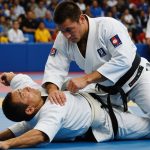Maximize Your Kickboxing Strength: The Ultimate Resistance Band Guide for UK Fighters
Why Resistance Bands are a Game-Changer for Kickboxing
When it comes to kickboxing, having the right training tools can make a significant difference in your performance and overall strength. One of the most versatile and effective tools you can add to your training arsenal is the resistance band. These bands are not just for casual workouts; they are a powerful tool for building the strength, power, and speed that kickboxing demands.
Resistance bands offer several advantages over traditional weights. They are lightweight, portable, and can be used in a variety of settings, whether you’re training at home, in the gym, or even outdoors. Here’s what makes them so effective:
Also read : Enhancing athletic recovery: the impact of massage therapy on combat sports athletes in the uk
- Convenience: Resistance bands are easy to carry around, making them perfect for fighters who need to train on the go.
- Versatility: You can use resistance bands for a wide range of exercises, targeting both the upper and lower body.
- Progressive Resistance: Unlike traditional weights, resistance bands provide continuous tension throughout the range of motion, which can help improve strength and power more effectively.
Choosing the Right Resistance Bands for Your Training
Not all resistance bands are created equal. Here are some key factors to consider when selecting the right bands for your kickboxing training:
Material and Durability
Look for bands made from high-quality materials that can withstand the intensity of your workouts. Rubber and latex bands are popular choices due to their durability and resistance levels.
Topic to read : Ultimate nutrition strategies for effective muscle recovery: essential insights for uk combat sports athletes
Resistance Levels
Resistance bands come in various resistance levels, often color-coded for ease of identification. Here’s a general guide to help you choose:
| Resistance Level | Color | Suitable For |
|---|---|---|
| Light | Yellow/Green | Beginners or warm-up exercises |
| Medium | Blue/Red | General strength training |
| Heavy | Black/Purple | Advanced strength and power training |
| Extra Heavy | Silver/Grey | Elite athletes or high-intensity training |
Length and Type
Bands come in different lengths and types, such as loop bands, tube bands, and mini bands. Loop bands are great for full-body exercises, while tube bands are better for specific muscle groups.
Essential Exercises for Kickboxing Strength Training
Here are some essential exercises you can incorporate into your training using resistance bands to improve your kickboxing strength:
Upper Body Exercises
- Banded Punches: Attach the band to a stable object and perform punching motions. This helps improve hand speed and power.
- Example: Hold the band in each hand and throw jabs, hooks, and uppercuts.
- Banded Shoulder Rotations: This exercise targets the shoulders, which are crucial for stability and power in punches.
- Example: Hold the band in one hand and rotate your shoulder in a circular motion.
Lower Body Exercises
- Banded Squats: This exercise strengthens your legs, which are essential for kicks and stability.
- Example: Wear the band around your legs just above the knees and perform squats.
- Banded Lunges: This targets the legs and glutes, improving balance and kicking power.
- Example: Wear the band around your legs and perform walking lunges.
Core Exercises
- Banded Rotational Throws: This exercise targets the core muscles, which are vital for stability and generating power in kicks and punches.
- Example: Hold the band in both hands and twist your torso, mimicking the motion of a kick or punch.
Detailed Exercise List
Here’s a more detailed list of exercises you can do with resistance bands to enhance your kickboxing training:
-
Warm-Up Exercises
-
Banded Leg Swings: Targets the legs and hips.
- Example: Attach the band to a stable object and swing one leg forward and backward, then switch to the other leg.
-
Banded Arm Circles: Targets the shoulders and arms.
- Example: Hold the band in both hands and make circular motions with your arms.
-
Strength Training Exercises
-
Banded Deadlifts: Targets the entire lower body and back.
- Example: Wear the band around your legs and lift, keeping your back straight.
-
Banded Push-Ups: Targets the chest, shoulders, and triceps.
- Example: Place the band around your back and perform push-ups.
-
Power and Speed Exercises
-
Banded Shadow Boxing: Targets the entire upper body and improves hand speed.
- Example: Attach the band to a stable object and perform shadow boxing movements.
-
Banded Kicks: Targets the legs and improves kicking speed and power.
- Example: Wear the band around your leg and perform kicks against the resistance.
Table: Comparing Different Types of Resistance Bands
Here’s a comparative table to help you choose the right type of resistance band for your kickboxing training:
| Type of Band | Material | Length | Resistance Levels | Suitable For |
|---|---|---|---|---|
| Loop Bands | Rubber/Latex | Variable | Light to Extra Heavy | Full-body exercises, lower body |
| Tube Bands | Rubber/Latex | Fixed | Medium to Heavy | Specific muscle groups, upper body |
| Mini Bands | Rubber/Latex | Short | Light to Medium | Core and leg exercises |
| Figure 8 Bands | Rubber/Latex | Fixed | Medium to Heavy | Upper body and shoulder exercises |
Practical Tips and Advice
Here are some practical tips to get the most out of your resistance band training:
- Start Slow: Begin with lighter resistance levels and gradually increase as you build strength.
- Quote: “Progressive overload is key to strength training. Start where you can handle the resistance and increase it as you get stronger,” says a kickboxing coach.
- Focus on Form: Ensure you maintain proper form during exercises to avoid injury and maximize the effectiveness of the workout.
- Example: When doing banded squats, keep your back straight and knees behind your toes.
- Incorporate High-Intensity Intervals: High-intensity interval training (HIIT) with resistance bands can significantly improve your power and speed.
- Example: Perform 30 seconds of banded punches followed by 30 seconds of rest, and repeat for several rounds.
Integrating Resistance Bands into Your Existing Training Routine
Resistance bands can be seamlessly integrated into your existing kickboxing training routine. Here’s how:
Warm-Up and Cool-Down
Use resistance bands for your warm-up and cool-down sessions. For example, banded leg swings and arm circles can help get your muscles ready for the intense workout ahead.
Strength Conditioning
Incorporate resistance band exercises into your strength conditioning days. For instance, banded deadlifts and squats can complement your weightlifting routine.
Shadow Boxing and Sparring
Use resistance bands during shadow boxing sessions to improve hand speed and power. You can also wear bands during sparring to add an extra layer of resistance.
Resistance bands are a versatile and effective tool for kickboxing training, offering a range of benefits from convenience and versatility to progressive resistance. By choosing the right bands, incorporating them into your training routine, and focusing on proper form and progressive overload, you can significantly improve your strength, power, and speed.
Remember, the key to maximizing your kickboxing strength is consistent and well-structured training. With resistance bands, you can take your training to the next level, whether you’re a beginner or an advanced fighter.
Final Tips
- Sign Up for New Workouts: Always look for new and innovative ways to use resistance bands in your workouts.
- Example: Follow fitness influencers or join online communities to discover new exercises and routines.
- Order New Bands: As you progress, order new bands with higher resistance levels to continue challenging your body.
- Example: If you’ve mastered the medium resistance level, it’s time to move to the heavy or extra heavy level.
- Improve Your Performance: Continuously monitor your performance and adjust your training accordingly.
- Quote: “The best fighters are always looking for ways to improve. Resistance bands are a great tool to add to your arsenal,” says a professional kickboxer.
By integrating resistance bands into your kickboxing training, you’ll be well on your way to enhancing your strength, power, and overall performance in the ring.











